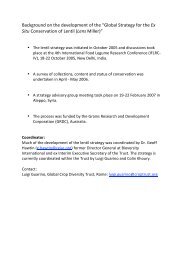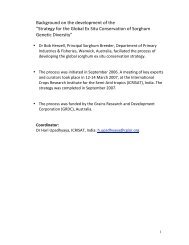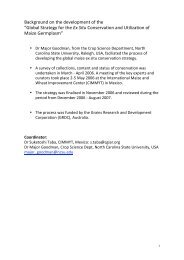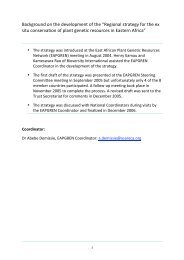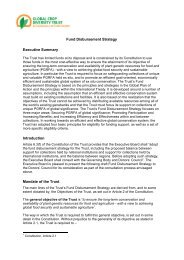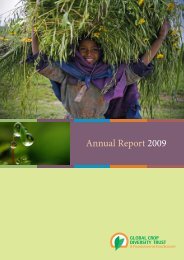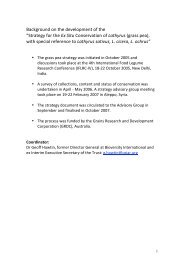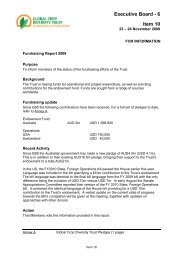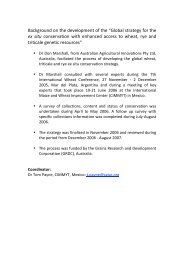Global Strategy for the Ex Situ Conservation of Potato - Global Crop ...
Global Strategy for the Ex Situ Conservation of Potato - Global Crop ...
Global Strategy for the Ex Situ Conservation of Potato - Global Crop ...
Create successful ePaper yourself
Turn your PDF publications into a flip-book with our unique Google optimized e-Paper software.
genebank members. Participation <strong>of</strong> its members in meetings has varied, whereas all potato<br />
curators have been welcome to participate in APIC meetings. Since 1992 APIC members<br />
organized six joint collecting missions to regions <strong>of</strong> <strong>the</strong> centre <strong>of</strong> diversity <strong>of</strong> potato, including<br />
Mexico, Peru, <strong>the</strong> USA and Central America). APIC has established databases <strong>for</strong> wild<br />
species and <strong>for</strong> native cultivars <strong>of</strong> <strong>the</strong> centre <strong>of</strong> diversity (Huamán et al., 2000a; Hoekstra,<br />
2002).<br />
The ECP/GR Working Group on <strong>Potato</strong> was established in 2000 at <strong>the</strong> closure <strong>of</strong> <strong>the</strong> EU-<br />
GENRES project on potato (1996-2000). This EU project involved 12 partners <strong>of</strong> six EU<br />
countries. Its major objectives were:<br />
! <strong>the</strong> establishment <strong>of</strong> central data bases <strong>of</strong> potato collections <strong>for</strong> Europe,<br />
! <strong>the</strong> improvement <strong>of</strong> <strong>the</strong> health status <strong>of</strong> European collections,<br />
! <strong>the</strong> characterization and evaluation <strong>of</strong> potato germplasm, and<br />
! <strong>the</strong> rationalization <strong>of</strong> collections.<br />
The ECP/GR Working Group on <strong>Potato</strong> continued most <strong>of</strong> <strong>the</strong> activities initiated by <strong>the</strong> EU<br />
project and counts presently 28 members <strong>of</strong> most European countries (Hoekstra et al.,<br />
2001). Two meetings have been organized, <strong>the</strong> last one in 2002 in Hamburg. In addition to<br />
<strong>the</strong> fur<strong>the</strong>r development <strong>of</strong> <strong>the</strong> APIC database on wild species by <strong>the</strong> Centre <strong>of</strong> Genetic<br />
Resources, <strong>the</strong> Ne<strong>the</strong>rlands (Hoekstra, 2002), a European Cultivated <strong>Potato</strong> Database was<br />
established by SASA, UK (Hoekstra and Carnegie, 2001). Details on <strong>the</strong> two databases can<br />
be found on <strong>the</strong> Internet at www.potgenebank.org (IPD, APIC) and www.europotato.org<br />
respectively. More details on <strong>the</strong> collections included in <strong>the</strong>se databases are presented in<br />
<strong>the</strong> tables <strong>of</strong> Annex 5.<br />
CIP is involved in three collaborative projects with genebanks and organizations in South<br />
America and one global project on cryopreservation (Willy Roca, presentation at Workshop<br />
CIP, 2005). These projects are:<br />
! “homologisation” <strong>of</strong> Andean cultivated native potato collections with <strong>the</strong> aim to assess<br />
potential duplication in <strong>the</strong> collections from Bolivia, Peru, Ecuador and <strong>the</strong> collection held<br />
at CIP;<br />
! characterisation <strong>of</strong> wild potato collections with <strong>the</strong> purpose to characterize <strong>the</strong><br />
reproductive parameters <strong>of</strong> wild species, in three locations in Peru; cooperation with<br />
three universities in Peru;<br />
! in situ conservation <strong>of</strong> native potato cultivars to promote on-farm conservation in<br />
biodiversity hotspots through community-based management linked to ex situ activities<br />
<strong>for</strong> restoring crop diversity in <strong>the</strong> Andes. Cooperation with NGOs, local governments and<br />
farmers in Peru (3 partners) and Venezuela (3 partners);<br />
! potato cryopreservation to develop and establish cryocollections <strong>of</strong> potato germplasm,<br />
as part <strong>of</strong> a network <strong>of</strong> cryocollections <strong>for</strong> clonally propagated crops; cooperation with<br />
Catholic Univ. <strong>of</strong> Leuven, Belgium; CIAT, Columbia; IITA, Nigeria; and INIBAP, France).<br />
Bilateral cooperation between potato genebanks also occurs, particularly in <strong>the</strong> field <strong>of</strong><br />
collecting missions, safety duplication, training and exchange <strong>of</strong> materials.<br />
Between 1970 and 1987 CIP organised four Planning Conferences on <strong>the</strong> conservation <strong>of</strong><br />
potato genetic resources. <strong>Potato</strong> curators from all over <strong>the</strong> world participated in <strong>the</strong>se<br />
meetings and discussed research, conservation strategies and exploration activities.<br />
Un<strong>for</strong>tunately, <strong>the</strong> last meeting was organized as long ago as in 1987. The recent Lima<br />
workshop at CIP was a first opportunity <strong>for</strong> potato curators to discuss conservation strategies<br />
at <strong>the</strong> global level again.<br />
16




